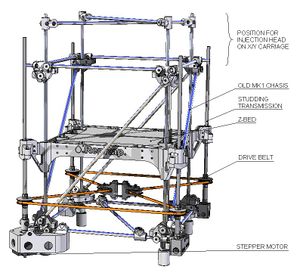ShowCase
Contents
RepRap Showcase
This page summarises the progress of the RepRap team so far. It is a very general summary of the blog and should save you time in finding out where we are with the project. However, if you're after the very latest information and news then the blog is where it's at.
[Rappers - lets keep this as brief, history is irrelevant, and untechnical as poss]
The three major areas we're working on are:
- Hardware
- Electronics
- Software
And when they're all brought together we'll have a replicating rapid-protyper.
Hardware
What's the machine going to look like? Well, we're working on three different concepts at the same time. When they're all done we can take the best bits from each concept and come out with an all-singing, all-dancing hybrid architecture.
Vik's: Da Witch
Da Witch (named after a recycled DAta sWITCH panel) is a 3-axis RepRap prototype with a single static head. Apart from the frame, rods and fastenings, all parts are FDM'd on a Stratasys. All the axes are screw-driven using salvaged unipolar stepper motors, and have a single limit switch each. The extruder is currently a slightly modified Mk2 extruder with an 0.8mm nozzle, all driven off a unidirectional gearmotor that bears a startling resemblance to a low-end Black & Decker electric screwdriver. The software is standard PIC16F628A code compiled with Open Source, cross-platform tools. It is notable because it is actually fully-functional - if completely uncallibrated - allowing concepts and software to be tested.
Recently, a cooling fan has been added, and a second head is in the works. The stage has been surfaced with sanded wood, which has proved to be an excellent deposition surface.
Forrest's: Godzilla
Y-axis cabling
X, Y and Z positioning stages are powered up. Work is currently underway to develop control boards that incorporate PWM speed control of the brushed DC motors that drive the positioning stages with shaft encoders to precisely determine the speed and position of each stage. PWM speed control of the smaller G4 motor has been demonstrated. Extension of the software to the larger, much faster positioning motors awaits the arrival of L298N h-bridge chips. Presently, control board work is caught in the learning curve of getting pulse inputs from the shaft encoder to work in an interrupt mode.
Ed's: A.R.N.I.E.
A concept inspired by traditional 2D printing technology. The injection head will be mounted on the top of the frame to be moved in the x and y planes to print each layer of the part. The first layer will be printed directly onto the z-bed which will then be incremented downwards in the z direction for each subsequent layer.
Progress: The z-bed transmission is complete (see below) and now work has started on the x and y to install the injection head.
Brett's: King Ghidorah
Electronics
RepRap doesn't have a single controlling computer. Each of its components has a microcontroller, the only job of which is to control its particular component. Thus each drive motor and each material write head has a microcontroller to itself that keeps its temperature constant, decides what speed to deposit material, and so on.
All the microcontrollers (Microchip PICs) are connected in a token ring, along with the PC that is controlling the whole RepRap machine. Each microcontroller has a unique number - its address - and messages are passed round the ring until they arrive at the PIC that has been addressed. Anything can talk to anything else, including the controlling PC, of course.
Software
-- Main.EdSells - 03 Jul 2006

